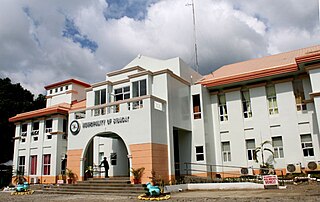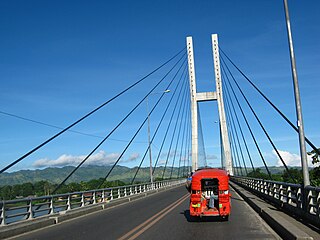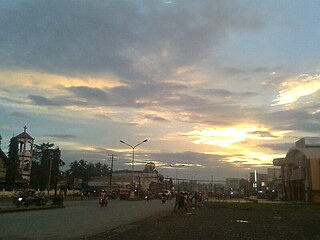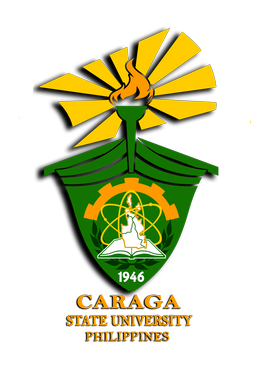
Mindanao is the second-largest island in the Philippines, after Luzon, and seventh-most populous island in the world. Located in the southern region of the archipelago, the island is part of an island group of the same name that also includes its adjacent islands, notably the Sulu Archipelago. According to the 2020 census, Mindanao has a population of 26,252,442 people, while the entire island group has an estimated population of 27,021,036 according to the 2021 census.

Agusan del Norte, officially the Province of Agusan del Norte, is a province in the Caraga region of the Philippines. Its capital is the city of Cabadbaran with several government offices located in the highly-urbanized city of Butuan. It is bordered on the northwest by Butuan Bay; northeast by Surigao del Norte; mid-east by Surigao del Sur; southeast by Agusan del Sur, and southwest by Misamis Oriental.

Caraga, officially the Caraga Administrative Region and designated as Region XIII, is an administrative region in the Philippines occupying the northeastern section of Mindanao. The region was created through Republic Act No. 7901 on February 23, 1995. The region comprises five provinces: Agusan del Norte, Agusan del Sur, Dinagat Islands, Surigao del Norte, and Surigao del Sur; six cities: Bayugan, Bislig, Butuan, Cabadbaran, Surigao and Tandag; 67 municipalities and 1,311 barangays. Butuan, the most urbanized city in Caraga, serves as the regional administrative center.

Sibagat, officially the Municipality of Sibagat, is a 1st class municipality in the province of Agusan del Sur, Philippines. According to the 2020 census, it has a population of 33,957 people.

Butuan, officially the City of Butuan, is a 1st class highly urbanized city in the region of Caraga, Philippines. It is the de facto capital of the province of Agusan del Norte where it is geographically situated but has an administratively independent government. According to the 2020 census, it has a population of 372,910 people.

Cabadbaran, officially the City of Cabadbaran, is a sixth class component city and de jure capital of the province of Agusan del Norte, Philippines. According to the 2020 census, it has a population of 80,354 people.

Magallanes, officially the Municipality of Magallanes, is a 4th class municipality in the province of Agusan del Norte, Philippines. According to the 2020 census, it has a population of 22,293 people.

Bayugan, officially the City of Bayugan, is a 5th class component city in the province of Agusan del Sur, Philippines. According to the 2020 census, it has a population of 109,499 people..

San Francisco, officially the Municipality of San Francisco, is a 1st class municipality in the province of Agusan del Sur, Philippines. According to the 2020 census, it has a population of 80,760 people.

The Pan-Philippine Highway, also known as the Maharlika Highway, is a network of roads, expressways, bridges, and ferry services that connect the islands of Luzon, Samar, Leyte, and Mindanao in the Philippines, serving as the country's principal transport backbone. Measuring 3,379.73 kilometers (2,100.07 mi) long excluding sea routes not counted by highway milestones, it is the longest road in the Philippines that forms the country's north–south backbone component of National Route 1 (N1) of the Philippine highway network. The entire highway is designated as Asian Highway 26 (AH26) of the Asian Highway Network.

Caraga State University is a state-owned university in Agusan del Norte, Philippines. Its main campus is in Ampayon, Butuan with an auxiliary campus in Cabadbaran.
The Wawa River is a river located in Caraga, in northeastern Mindanao, in the southern Philippine island. Its headwaters traverse the municipality of Sibagat, Bayugan, and Esperanza. The Wawa River is a tributary of the larger Agusan River.

Maria Angelica Rosedell Malbas Amante-Matba, is a Filipino registered nurse and politician currently serving as the governor of Agusan del Norte, a position she previously held from 1995 to 2004 and from 2013 to 2019. She was also a member of the House of Representatives of the Philippines representing Agusan del Norte's 2nd congressional district.
The Surigao–Davao Coastal Road or the President Diosdado P. Macapagal Highway is a 677-kilometer (421 mi), two-to-six lane highway that connects the provinces of Surigao del Norte, Surigao del Sur, Davao Oriental, Compostela Valley, and Davao del Norte. It connects the Maharlika Highway in Placer, Surigao del Norte to the Agusan in Tagum. Running along the eastern coast of Mindanao, it is one of the longest roads in the Philippines.

The Butuan–Cagayan de Oro–Iligan Road, or Butuan–Cagayan de Oro–Iligan–Tukuran Road, is a 416-kilometer (258 mi), two-to-six lane major thoroughfare, connecting the provinces of Agusan del Norte, Misamis Oriental, Lanao del Norte, and Zamboanga del Sur.

Mayor Democrito D. Plaza II Avenue is a 15.5-kilometre (9.6 mi), two-to-four lane national secondary highway in Butuan. It serves as a diversion road from the Butuan–Cagayan de Oro–Iligan Road.
The Boguko River is a stream located in Sibagat, Agusan del Sur, Caraga Region, Philippines. It is a tributary of the larger Wawa River with headwaters located in the mountain boundaries of Sibagat and the Province of Surigao del Sur.
Guicam Bridge is a 1.2 km (0.75 mi) concrete girder bridge being planned for construction between the towns of Alicia and Mabuhay in Zamboanga Sibugay, Philippines. The bridge will connect Olutanga Island and its three municipalities of Mabuhay, Talusan, and Olutanga with the rest of Mindanao Island, which are separated by the Canalizo Strait. Once completed, it will be the longest bridge in Mindanao until the completion of the 3.77 km (2.34 mi) Panguil Bay Bridge between Tangub, Misamis Occidental and Tubod, Lanao del Norte.

National Route 9 (N9) is a 416-kilometer (258 mi), two to six major primary route network connecting the provinces of connecting the provinces of Agusan del Norte, Misamis Oriental, Lanao del Norte, and Zamboanga del Sur.

















